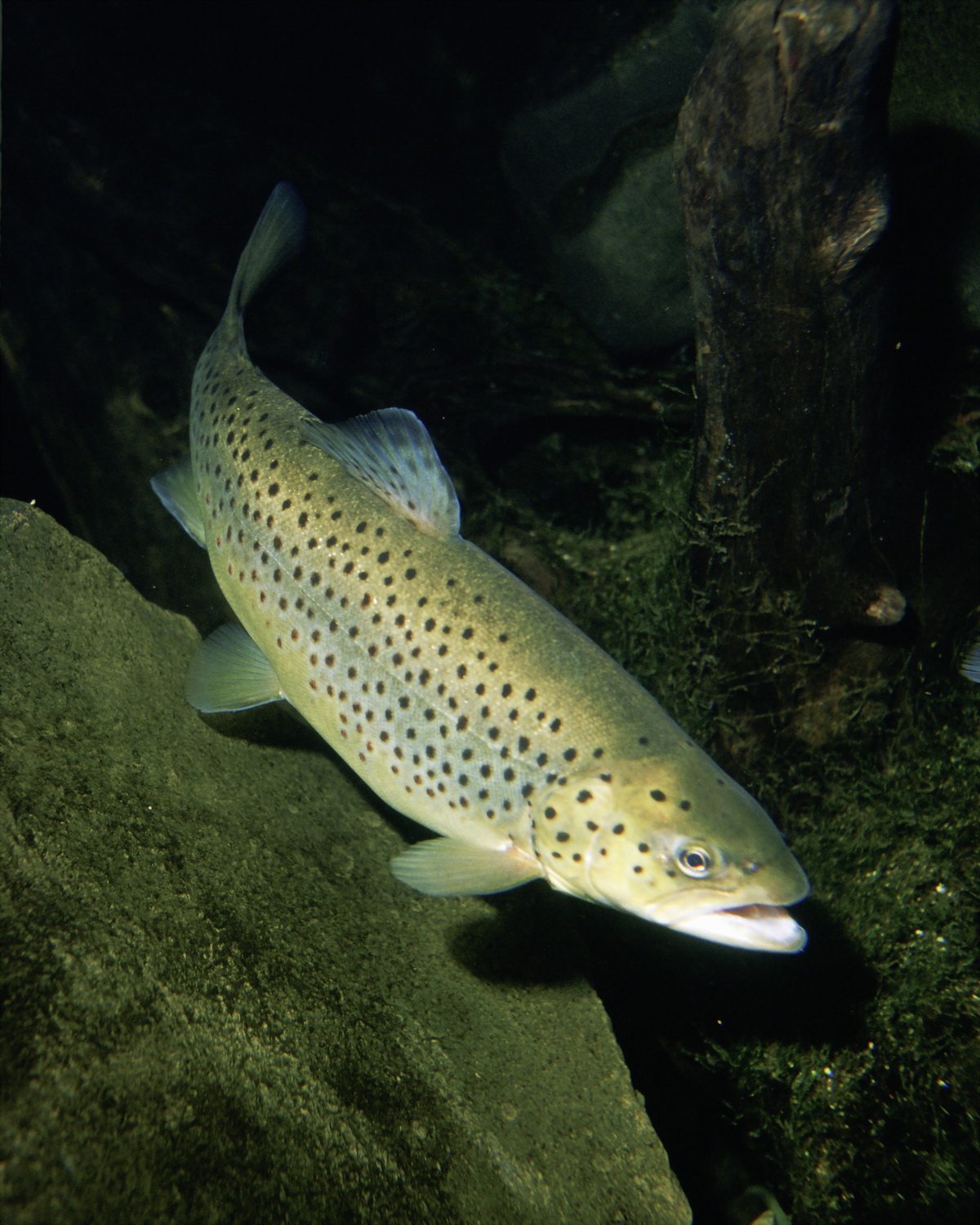Brown Trout (Salmo trutta) - Wiki Brown trout
From Wikipedia, the free encyclopedia
[Photo] Brown Trout (Salmo trutta). Creator: Engbretson, Eric. Publisher: U.S. Fish and Wildlife Service
The brown trout (Salmo trutta morpha fario and S. trutta morpha lacustris) and the sea trout (S. trutta morpha trutta) are fish of the same species.
They are distinguished chiefly by the fact that the brown trout is largely a freshwater fish, while the sea trout shows anadromous reproduction, migrating to the oceans for much of its life and returning to freshwater only to spawn.
The lacustrine morph of brown trout is most usually potamodromous, migrating from lakes into rivers or streams to spawn, although there is some evidence of stocks that spawn on wind-swept shorelines of lakes. S. trutta morpha fario form stream-resident populations, typically in alpine streams but sometimes in larger rivers. There is evidence that anadromous and non-anadromous morphs coexisting in the same river can be genetically identical. In common usage, the name "brown trout" is often applied indiscriminately to the various morphs.
The brown trout is normally considered to be native to Europe and Asia but the natural distribution of the migratory forms may be, in fact, circumpolar. There are also landlocked populations far from the oceans, for example in Greece and Estonia. The fish is not considered to be endangered although, in some cases, individual stocks are under various degrees of stress mainly through habitat degradation, overharvest and artificial propagation leading to introgression. S. trutta morpha fario prefers cold (though in comparison with other trout, this species has a somewhat higher temperature preference of about 60-65 F, or 15.5-18.3 C), well-oxygenated upland waters, especially large streams in mountainous areas. Cover is important to trout, and they are more likely to be found where there are submerged rocks, undercut banks, and overhanging vegetation.
The brown trout is a medium sized fish, growing to 20 kg or more in some localities although in many smaller rivers a mature weight of 1 kg (2 lb) or less is common. The current International Game Fish Association (IGFA) world "all tackle" record brown trout, 18.25 kg (40 pounds, 4 ounces), was caught in May of 1992 from the Little Red River, Arkansas by Howard "Rip" Collins. (Story with images)
Brown trout may live for several years although, as with the Atlantic salmon, there is a high proportion of death of males after spawning and probably fewer than 20% of female kelts recover from spawning. The migratory forms grow to significantly larger sizes and may live longer. Brown trout are active both by day and by night and are opportunistic feeders. While in fresh water, the diet will frequently include invertebrates from the streambed, small fish, frogs, and insects flying near the water's surface. The high dietary reliance upon insect larvae, pupae, nymphs and adults is what allows trout to be a favoured target for fly fishing. Sea trout are especially fished for at night using wet flies.
The spawning behaviour of brown trout is similar to that of the closely related Atlantic salmon. A typical female produces about 2000 eggs per kilogram (900 eggs per pound) of body weight at spawning. Brown trout rarely form hybrids, almost invariably infertile, with other species. One such example is the tiger trout, a hybrid with the brook trout.
Trout is a favourite food fish, and is used both fresh and smoked; there are many recipes for it, and it may be eaten fried, grilled, baked or microwaved.
The specific epithet trutta derives from the Latin trutta, meaning, literally, "trout".
Stocking, farming and non-native brown trout
The species has been widely introduced for purposes of sport into North America, South America, Australia and New Zealand. Brown trout have had serious negative impacts on upland native fish species in some of the countries where they have been introduced, particularly Australia. Because of the trout's importance as a food and game fish, it has been artificially propagated and stocked in many places in its range, and fully natural populations (uncontaminated by allopatric genomes) probably exist only in isolated places, for example in Corsica or in high alpine valleys on the European mainland.
Farming of brown trout has included the production of infertile triploid fish by increasing the water temperature just after fertilisation of eggs, or more reliably by a process known as pressure shocking. Triploids are favoured by anglers because they grow faster and larger than diploid trout. Proponents of the stocking of triploids argue that, because they are infertile, they can be introduced into an environment that contains wild brown trout without the negative effects of cross-breeding. However, it is possible that stocking triploids may damage wild stocks in other ways. Triploids certainly compete with diploid fish for food, space and other resources. They could also be more aggressive than diploid fish and they may disturb spawning behaviour.
Sea trout populations in recent years have seriously declined due to infestation by sea lice from salmon farms.
http://en.wikipedia.org/wiki/Brown_trout
| The text in this page is based on the copyrighted Wikipedia article shown in above URL. It is used under the GNU Free Documentation License. You may redistribute it, verbatim or modified, providing that you comply with the terms of the GFDL. |
